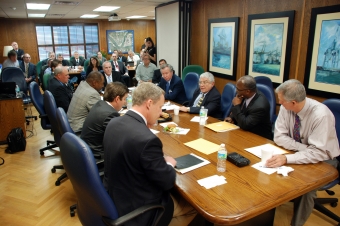Summary:
The activity focuses on the practice and the concepts involved in buying and selling stocks. Your goal is to develop competencies and skills relevant for the lawyer who acts in the business district. Therefore, the class is divided into groups of buyers and sellers. For each portion of the contract, a buyer and a seller group indicate changes that would make the contract to contemplate their interests, with the chances of acceptance by the other party.
Objective:
- GENERAL GOALS: to develop expertise and skills relevant to the business lawyer, such as the ability to analyze and comprehend the reality, critical sense and questioning attitude, perception of interests and positions, the identification of sensitive questions, strategic vision, teamwork and spirit of cooperation, creativity and innovation, and legal reasoning. In addition, the goal wants to address several themes in the area.
- SPECIFIC GOALS: to put the student in touch with the documentation used in a typical operation of buying and selling stocks, teach how to structure this type of operation and what are the important points that should be covered by the record. With this exercise, it is aimed that the student answers the question about making a report on the content of corporate law. At the same time, the aim is that students can identify problematic, central aspects and difficult to address these business situations of corporate transactions. It is expected that students arrive at balanced solutions of alternative proposals before those identified as problematic. The exercise also allows the training of students in handling and writing of own legal documents for these corporate situations (need to follow the proper legal form of a writing report), which is a knowledge not offered by the traditional legal doctrine.
Skills to be developed by the student: Analytical ability; Ability to formulate appropriate solutions; Strategic vision.
Dynamics:
- Method: case method, which includes critical reading of documents (contract) and role-playing (seeking for the active student participation).
- Requirements: all the students had prior access to an extensive report of purchase and sale of company stocks (bilingual: English / Portuguese) containing over 100 pages. The report was a real case, but it was intentionally modified by the professor to introduce bias, in order that the students were able to identify them and propose, collectively, a balanced alternative writing reports. The students were unaware of such changes, having access only to the modified version. Through the length of the document, it was divided into about seven chapters/sections and the class was divided in double of this number in work groups, as for each contract section it was needed the perspective of the buyer and seller.
- General requirement for the class: the preparation for each class includes reading a previously selected bibliography from three more conceptual questions of the material, informed in advance by the professor. Thus, all students performed a broader forethought on the questions of purchase and sale of companies. As required reading, the classes required the following texts: 1) BOTREL, Sérgio. Fusões & Aquisições. São Paulo: Saraiva, 2012; (2) FREUND, James C. Anatomy of a merger. Strategies and techniques for negotiating corporate acquisitions. New York: Law Journal Press, 1975 (reprinted 2004); (3) CARNEY, Willian J. Mergers and acquisitions – cases and materials. New York: Foundations Press – Thompson Reuters, 2011, 3ª ed.; (4) AMERICAN BAR ASSOCIATION. Model joint venture agreement with commentary. ABA Section of Business Law, 2006.
As complementary reading suggested, the classes required on the following texts: (1) AMERICAN BAR ASSOCIATION. The M&A process. A practical guide for business lawyer. ABA section Business Law, Committee on negotiated acquisitions, 2005, p. 5-29 (Chapter 2 – Managing the client relationship and other ethical issues); (2) BAINBRIDGE, Stephen M. Mergers and Acquisitions. New York: Foundation Press, - Thomson Reuters, 2011, p. 71-97 (Chapter 3 - The acquisition agreement – Ensuring exclusivity); (3) GAUGAHAN, Patrick A. Mergers, acquisitions and corporate restructurings. 4 ed. New Jersey: John Wiley & Sons, 2007, p. 3-28 (Chapter 1 – Introduction); (4) DEPANPHILIS, Donald M. Mergers, acquisitions and other restructuring activities. Amsterdam: Elsevier, 2010.
- INTRODUCTION TO THE DYNAMICS: in the first class, at the beginning of the year, the professor gave a presentation on the logic of a contract of this nature and its main points.
- DEVELOPMENT OF THE DYNAMICS: According to the order of chapters, each pair of each group projected on the screen their changes/observations marking the document, so that the changes could be viewed by everyone. The dynamics moved forward with the study of each contract part from the dialogue-based presentation of the document by two groups, the seller and buyer. For each problem, omission relevant, failure, bias or inadequate solution found in the report, the group proposed (from their perspective) an alternative writing to be adopted, always considering that the proposal should be balanced, and likely to be accepted by other part. For each identified situation, the two groups presented the problem from their perspective and made writing proposals. The professor made the mediation, some clarifications, punctuated aspects to be considered and clarified concepts. The dynamics sought to simulate the typical scheme of work in a law firm, in which a group work on a document and then present it to the other for discussion, with a lawyer leader who guides the work. The purpose of the groups was to find solutions that make sense for both parties. In this case, it was possible to address two chapters of the report per class (50 min).
- END OF THE CLASS: each class had a closure, but it was not planned because it was resulted from the discussion itself.
- ATTENTION IN THE CLASSROOM: the class involved the use of visual resources for each group to present the document with their own proposals of modifications marked in print. They were exposed at the same time the proposals of the two conflicting parties, from the seller and the buyer. For this, it was necessary to design files. A dynamics challenge has to do with students who do not participate directly during the exhibition. A large group hinders their connection/attention (although they may participate). The good result of the need of the dynamic for the students improved analysis. Superficial proposals turn difficult the objectives. It is needed to consider the profile of students to estimate how long they are willing to invest in advance in preparation for the shares.
Evaluation:
- Return to students: the professor said to the students they were meeting the expectations.
- Grade evaluation: It was assigned a grade for their participation in the seminar (collective grade). The criteria to evaluate the group were: identification and display of relevant points, diligence, preparation, and interest in the exercise. The students who had not presented were also evaluated by a general participation grade given to the course.
Observation:
The fragmentation of the document depends on its size and the time of application, in turn, arises from this dimension. In the reported activity, there were necessary seven classes (one per chapter in which the report was divided). A smaller report needs less chapters and less time in class. It is not a negotiation exercise. There is no obligation to reach a consensus. Nothing prevents, however, that the exercise will serve to this purpose. It is recommended that exercise is not intended for students with extensive luggage in the area, but for those who are very interested in how it is done. The exercise is recommended for 20 students classes, so that 1/3 present and 2/3 attend and participate in a timely manner. In this case, the conformation of the groups was spontaneous (choosing who would be part of the group).
Copyright from the cover page image (cropped):
Image: "Yahoo! and Samsung Extend Strategic Mobile Global Partnership", 2010, available by the user "Yahoo", under the Creative Commons BY-2.0 license.






